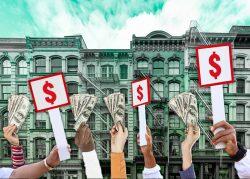What would a tenant pay for a 625-square-foot one-bedroom in Greenpoint, two blocks from McCarren Park?
With Covid cases receding again, real estate agent David Kazemi figured $3,500.
The apartment at 156 Guernsey Street, a refurbished railroad-style unit with plenty of light and a home office, but no amenities or outdoor space, had rented for $3,000 before the pandemic and $2,600 last year.
“The lease was coming up again and I was like, look: The pendulum swings the other way. The market is super hot right now. Why don’t we list it for $3,450?” said Kazemi.
His brokerage, BOND New York, posted the listing. Within 10 minutes, the agent said, “I was getting inundated.”
BOND bumped the price by $50, but the emails kept coming: 75 in 48 hours. The firm held a showing. In 90 minutes, 18 people saw the apartment and six put in applications. Five offered more than the asking rent.
Trumping bids of $3,550, $3,600 and $3,700, one applicant offered $3,800 for the unit “as is” — then sweetened the deal.
“Don’t paint the apartment,” the apartment hunter told Kazemi. “I’ll pay your broker’s fee. I’ll sign a two-year lease.”
“Unbelievable,” the agent said.
Welcome to the city’s super-charged rental market. What’s especially unusual is that winter is typically when tenants hunker down and await better moving weather and the spring listings surge.
Brokers call this season’s market unprecedented. After the delta and omicron variants delayed return-to-office plans, renters are returning to the city in anticipation of being at their desks this spring.
That influx coupled with low vacancy has made for fierce competition. Bidding wars have become routine, as have waitlists for properties leasing as late as June. Leases are being signed for apartments sight-unseen.
In many ways, it is an acceleration of a year-long trend. When renters got vaccinated and moved back to the city last spring, units that had been gathering dust finally started to move. By summer, owners were yanking their Covid concessions and raising prices.
Rents recovered to pre-pandemic levels in October, when the median price for a one-bedroom hit $3,945, up 12.7 percent from a year earlier, according to Douglas Elliman’s rental market report. It was the steepest annual jump in a decade.
Agents said they expected a winter lull; October typically marks the beginning of the slow season.
But after dipping as omicron tore through New York in November and December, the median price for rentals jumped 2.2 percent in January to $3,550, the second-highest rent on record for the month. The Elliman report credited a low vacancy rate of 1.7 percent and a drop in listing inventory.
“It’s been the busiest January I’ve ever had,” said Stan Broekhoven, an agent for Keller Williams. “And I’ve been doing this for quite a long time.”
Read more


Brokers say that demand has fueled Brooklyn markets from Greenpoint to Williamsburg to Park Slope. In downtown Manhattan, the West Village, East Village and Chelsea have all seen bidding wars.
Everything from luxury rentals to four-bedroom shares are hot tickets.
Last week, one of Broekhoven’s clients bid $500 over the $6,000 listing price for an apartment in Williamsburg — and lost. The listing agent told Broekhoven that the owner had accepted a “much stronger offer.”
Devin Someck, a principal at brokerage Living New York, said the low inventory squeezing apartment hunters is likely the result of longer leases being signed during Covid. Last year, landlords lopped off a few months’ rent for tenants committing to 15 or 18 months. Those apartments, if they rented last spring, won’t be available until summer or early autumn.
“Are you moving?”
Owners are preparing by listing units months before leases are set to expire, Broekhoven said.
“Typically most landlords will reach out to tenants 60 days before the lease expires and ask if they’re renewing,” Broekhoven said. “Now the landlords are being a bit more aggressive because there’s no inventory. They’re going to people 90 days out, even 120 days out from their leasing expiration, like: ‘Hey, are you moving?’ he said.
Some buildings have created waiting lists for units set to come to market, something Broekhoven has “never seen before.”
And because tenants are more willing to lease apartments sight unseen, properties are being scooped up at a breakneck pace. Brokers said “immediate signings,” within days or hours of a listing going live, are becoming the norm.
“We got used to [virtual showings] during the pandemic,” Broekhoven said. “But now you can’t even get to the units to show them because someone is still living there.”
His advice for tenants set on a certain neighborhood or building: Don’t expect to see the apartment in person until move-in day.
The competition is so great that some professionals relocating for work, who might have wanted to rent until getting a feel for the city, are instead buying to avoid the chaos and expense of the rental market.
A few neighborhoods have yet to see that over-the-top demand. Someck said that rentals in the Financial District and Midtown East have been more challenging to fill, as most workers don’t yet have a reason to live within walking distance to work. Broekhoven said the Upper East Side also has affordable options.
What’s next
It’s possible that once Covid-era leases expire, inventory will grow and prices will level off. But that’s only if enough of those tenants don’t renew.
Rents have risen by 24 percent since last February, according to data from Zumper, making New York the most expensive city in the country.
Broekhoven said the rising prices and low availability could prompt tenants to renew. Some who have been good tenants may hope their landlord will offer them a better deal than what they would find on the market. Others will not want to deal with the “struggle” of getting an apartment now, Broekhoven said.
One more factor is poised to affect the market this summer: the return of students.
Lease signings among university-age tenants have ticked up but are not back to pre-pandemic levels, Someck said, as some schools are still offering remote learning. City University of New York will offer at least 30 percent of its courses remotely this spring. New York University kicked off the semester allowing remote learning on a case-by-case basis.
If colleges continue with hybrid models, Someck said, students might rent in cheaper markets farther from campus. That could spark price hikes in those neighborhoods.
Come what may, it’s clear that many agents and renters are burned out. Some brokers have even started to pine for a slowdown.
“It’s stressful for people looking, stressful for us agents,” Broekhoven said. “I think everybody really wants things to cool down because it’s been taxing on everybody.”
